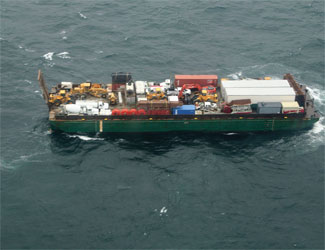The 68-foot tugboat Aries was pulling a barge loaded with heavy equipment in the Bering Sea when the crew began experiencing a terrifying sensation. In 10- to 11-foot seas and 30-mph winds, the crewmembers started feeling as though their tug was tipping over.
It was 0610 on June 26, 2011, and the tow was more than 100 miles from a safe harbor. The tilt got worse, so they radioed a distress call to the U.S. Coast Guard.
"Mayday! Mayday! Mayday!" the captain announced. "The tug Aries … listing severely to starboard, one barge in tow — over."
Coast Guard personnel in Kodiak, Alaska, received the message and sought to clarify the vessel's position and number of crew.
"Four persons on board … I believe we are taking on water. We have a severe list to starboard. Attempts to pump ballast and move fuel, so far, have been unsuccessful," the voice said. "We're listing approximately 30 or 25° to starboard — over."
 |
|
The deck barge KRS 240-5 is anchored in place by the submerged tugboat Aries one day after the tug sank in the Bering Sea in June. All four crewmembers evacuated to the barge and were rescued by helicopter. (Photo courtesy U.S. Coast Guard) |
The tugboat crew prepared to abandon ship. The Coast Guard launched an HC-130 Hercules airplane and an MH-60 Jayhawk helicopter. Later that morning, Aries sank in the 46° water.
In a press release, the Coast Guard confirmed the details of radio communications, "œreporting that the vessel was taking on water and the crew was donning their survival suits. The watchstanders issued an urgent marine information broadcast requesting any vessels in the area assist the Aries crew if possible."
The Coast Guard diverted the cutter Healy, which was in the Bering Sea. A fishing boat, Alaska Knight, responded as a good Samaritan vessel. When the Coast Guard plane arrived, the aviators found the loaded 230-foot deck barge but saw no sign of the 1,200-hp tug. Safely aboard the barge, however, were the four crewmembers.
"The crew was able to transfer to the barge before the tug sank," the Coast Guard statement said.
At the helm of Aries during the emergency was Capt. Doug Pine. In an interview with Professional Mariner, Pine reported that he carefully maneuvered the hobbled twin-screw tug back toward its barge, KRS 240-5. All crewmembers climbed aboard and stayed warm in a Chevy pickup truck that was part of the cargo of construction equipment.
The Coast Guard helicopter arrived at 1334, hoisted the three men and one woman and flew them to Alaska's St. Paul Island, 109 miles to the west.
Aries' list was 35° by the time the crew abandoned ship, Pine said. He had to steer carefully to ensure that the tug didn't heel over.
"I wanted to come alongside the barge at a right angle so we could just climb aboard on the ladder right from the push knees," Pine said. "If I had used left-rudder and throttled up, that would have driven the starboard quarter deeper into the water, which I didn't want to do. It was more of a sweeping right-hand turn. It had to be very gentle, because the barge was just drifting in the wind. I knew we would be in the trough."
Aries inched its way over to the barge, which was connected by 1,200 feet of steel tow wire. The heavy seas slammed the listing boat into KRS 240-5, causing some damage to the barge's hull.
"I whacked it pretty good with the push knees and put a little hole in the barge," he said. "With the boat heeling over the way it was, the tires weren't touching the barge. It was metal on metal."
All the while, Pine was operating the tug while wearing his survival suit. While he held the boat against KRS 240-5, his three crewmembers climbed aboard the barge safely. Then it was the master's turn. With no one at the helm controlling the boat, that would likely be more perilous. Pine switched to all-stop, centered the rudder and made a run for it.
"When I left the wheelhouse, I tossed a life ring into the water because I fully expected to be in the water. But I climbed up on the H-bitt and the boat slammed up against the barge one more time, and I went for it and I got it," Pine said. He grasped a hatch cover as he boarded the barge.
Aries sank 20 minutes later, in 280 feet of water. The submerged boat anchored the barge in place until rescuers arrived.
The Coast Guard is investigating the cause of the sinking. The tug contained 29,000 gallons of diesel fuel, and a sheen was spotted in the vicinity. The Coast Guard determined that the spill posed no danger to the Alaska coastline.
Aries was operated by C&K Marine of Anchorage. Co-owner Kevin Kennedy said a major leak must have opened up toward the stern.
"A seam or something let loose and it had to be in the aft ballast tank area between the ballast tank and wraparound void in order to take in enough water†to sink so quickly, Kennedy said.
Both Pine and Kennedy said the vessel behaved contrary to its stability letter.
"The engine room was bone dry when it went down," Kennedy said. "To me, I have a question about stability."
C&K had acquired Aries only about a month earlier. The 30-year-old tug underwent refurbishment in a Seattle yard before entering Alaska service.
